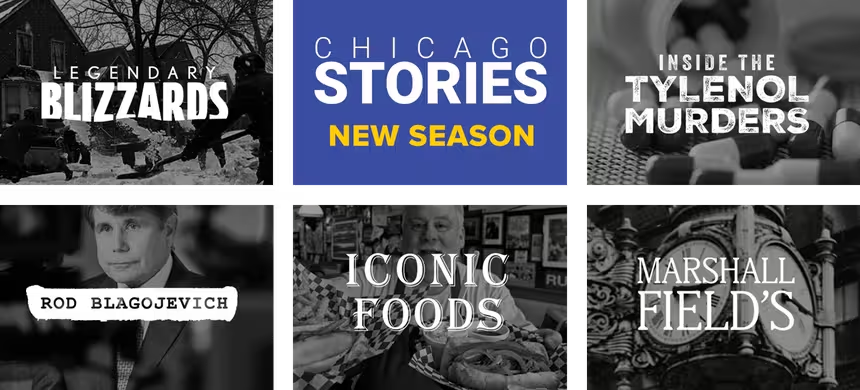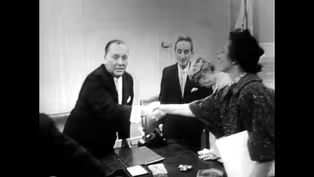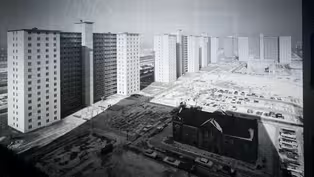Chicago Stories
Richard J. Daley’s Bridgeport Roots
Clip: 10/13/2023 | 8m 50sVideo has Closed Captions
Richard J. Daley grew up in Bridgeport, a community that influenced his political career.
Mayor Richard J. Daley grew up in Bridgeport, an Irish, South Side Chicago neighborhood that influenced his political career.
Problems playing video? | Closed Captioning Feedback
Problems playing video? | Closed Captioning Feedback
Chicago Stories is a local public television program presented by WTTW
Lead support for CHICAGO STORIES is provided by The Negaunee Foundation. Major support is provided by the Abra Prentice Foundation, Inc. and the TAWANI Foundation.
Chicago Stories
Richard J. Daley’s Bridgeport Roots
Clip: 10/13/2023 | 8m 50sVideo has Closed Captions
Mayor Richard J. Daley grew up in Bridgeport, an Irish, South Side Chicago neighborhood that influenced his political career.
Problems playing video? | Closed Captioning Feedback
How to Watch Chicago Stories
Chicago Stories is available to stream on pbs.org and the free PBS App, available on iPhone, Apple TV, Android TV, Android smartphones, Amazon Fire TV, Amazon Fire Tablet, Roku, Samsung Smart TV, and Vizio.

Chicago Stories - New Season!
Blizzards that brought Chicago to a standstill. A shocking unsolved murder case. A governor's fall from power. Iconic local foods. And the magic of Marshall Field's legendary holiday windows.Providing Support for PBS.org
Learn Moreabout PBS online sponsorship- [Narrator] To understand Richard J. Daley and how his dream of a modern city would shape Chicago for generations, it helps to venture back to Bridgeport and the predominantly Irish neighborhood of Daley's youth.
- You can still go to Bridgeport and find remnants of the old working-class neighborhood in which Daley grew up.
- [Narrator] Back then, Bridgeport sat on the edge of the Union Stockyards, a vast 350-acre parcel of stock pens and meatpacking plants.
- [Roger] It was a gritty, dirty neighborhood.
The water that flowed through Bridgeport was foul.
- [Narrator] Daley grew up here, the studious and only child of his second-generation Irish parents.
His father, Michael, was a union sheet metal worker.
His mother, Lillian, was a homemaker and a suffragette.
Marching alongside his mother, Daley was offered his first taste of politics.
- Daley's mother was a feminist.
She worked for the right for women to vote and was a feminist throughout her life.
- [Narrator] Lillian wanted more for her son than the South Side stockyards.
At the time, Bridgeport was a melting pot of blue-collar Irish, Lithuanian, Polish, and German.
- It was a neighborhood of lots of white ethnic groups, Eastern European groups.
Not Blacks, of course.
- [Narrator] In Bridgeport, heads turned when a stranger walked into a neighborhood tavern.
Blacks sought to avoid the area entirely.
- It was a hard neighborhood, but it was also one of those neighborhoods where the important things were God, family, and work.
In Daley's case, politics too.
And Bridgeport you could consider the birthplace of mayors, for goodness' sakes.
- [Narrator] Bridgeport would eventually grace the city with five mayors.
Two of them would be Daleys.
But Bridgeport's link to politics started much earlier, with the first Irish-Catholic settlers who'd fled famine and years of political conflict with England.
They arrived in the 1840s to find themselves at the bottom of Chicago's social hierarchy.
- The Irish in the South Side are called, I don't know if we can say this, "Pig-(censored) Irish."
And so, the Irish resent this.
Coming out of Ireland, which is the first colony of the United Kingdom, they know how democracy works and they know how it doesn't work for them because they're kept out of the British system.
And they wanna make sure that they're kept in the system here.
- [Narrator] If the Irish had arrived poor, they had one commodity of value: votes.
They joined up with Democrats who campaigned for the needs of the working class and against a surge of anti-Catholic sentiment.
- Politics is the most important game in town in Chicago.
You have to be involved with the political game if you wanna have power, if you wanna succeed.
- [Narrator] During Daley's youth, Chicago was a city full of neighborhoods like Bridgeport.
They were tight-knit enclaves united by class and race and a loyalty to their own kind.
Four miles north, at the edge of the Loop, was Chicago's Near West Side.
Here, bordered on each end by the Jewish and Greek business districts, an array of immigrants fought for a slice of the American dream.
- These were Italians, they were Bohemians, many Russians.
They were moving into that area mainly because that is where, very near where the factory district was.
It was also known for being one of the most impoverished.
- [Narrator] The city's largest enclave of Italian immigrants had settled around Taylor Street.
- There would be a whole apartment building of people from one particular village in Italy.
- This settlement pattern is totally common for every immigrant group.
And for Black folks moving from the South, it would've been everybody from Sunflower County, Mississippi, for example.
- [Narrator] Daley's teen years coincided with a surge in Chicago's Black population, as thousands of Blacks fled racism in the South.
Most settled on the city's South Side within a narrow corridor that spanned State Street.
The so-called Black Belt was separated from Bridgeport by train tracks.
But unlike the ethnic enclaves of Chicago, the borders of the Black Belt were strictly enforced.
- When Black people moved into a neighborhood that was majority white, there were house bombings.
I think it's always important when we think about Black neighborhoods to talk simultaneously about choice and about the lack thereof.
- [Narrator] For the most part in 1915, Black Chicagoans were excluded from white business establishments and they sent their children to predominantly Black schools.
- It was a city of diversity, but yet everybody had their separate neighborhoods.
There were boundaries.
There were, you know, lines drawn.
- (Roger) In Daley's own neighborhood, perhaps as much as any place in Chicago, there was a real tribalism.
There's our kind and then there's the other kind.
Not only because it's a matter of race and religion, but it's an economic matter too.
If other groups come in, then we're gonna lose everything.
(gentle music) - [Narrator] As a teen in Bridgeport, Daley found his friends within a close-knit group called the Hamburg Social and Athletic Club.
The club was also a training camp for Bridgeport's Democratic base.
During campaign seasons, Hamburg boys raised funds and got out the vote.
Hamburg Club members also saw themselves as neighborhood defenders.
- Bridgeport was proud of keeping Blacks out, keeping out any other race that was against their way of thinking.
- [Narrator] As the neighboring Black community competed for jobs and housing, Blacks became the least welcome of all.
- (Roger) For a long time, that growing Black population was kept bottled up in a very small area of the city, and oftentimes white Chicagoans defended those boundaries violently.
Tension had been building and the event that really triggered it came in the summer of 1919.
- [Narrator] That's when a 17-year-old Black youth named Eugene Williams was swimming off the 27th Street beach.
He drifted south, crossing an invisible line that separated the segregated beaches.
When Williams tried to come ashore, white beachgoers pelted him with stones until he drowned.
- [Roger] There were a lot of witnesses to this.
It was a packed beach, but the police who were there didn't do anything about it.
- [Narrator] The murder escalated into a riot, as Blacks and whites clashed in the streets.
African Americans were dragged from streetcars and beaten.
The Hamburg Club joined other white ethnic gangs in beating Blacks who crossed into Bridgeport territory.
The rioting spread across Chicago and became known as the Red Summer.
And the stain would follow Daley.
- His club was intimately involved.
And ever after, Daley's opponents were looking for gold.
They wanted to find evidence that he had been involved personally in that rioting.
They've never found it.
Whether or not he directly threw a punch, he understood what the emotions were like.
He understood his neighbors.
All of that became part of who he was.
- [Narrator] In 1924, Daley became the club's president, a move that would forge his political future.
- He got noticed.
He got noticed because he was organizing, because he was business-like,
Florence Scala and the Fight to Save Little Italy
Video has Closed Captions
Clip: 10/13/2023 | 7m 58s | A neighborhood activist fought to preserve Little Italy. (7m 58s)
Richard J. Daley’s Influence on Public Housing
Video has Closed Captions
Clip: 10/13/2023 | 5m 10s | While Chicago’s downtown changed, Daley oversaw a new public housing in Chicago. (5m 10s)
Providing Support for PBS.org
Learn Moreabout PBS online sponsorshipSupport for PBS provided by:
Chicago Stories is a local public television program presented by WTTW
Lead support for CHICAGO STORIES is provided by The Negaunee Foundation. Major support is provided by the Abra Prentice Foundation, Inc. and the TAWANI Foundation.

















